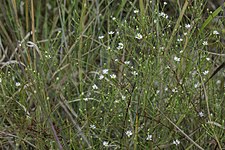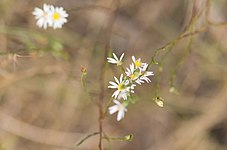Symphyotrichum depauperatum
| Symphyotrichum depauperatum | |
|---|---|
 | |
| S. depauperatum from the serpentine grassland demonstration area in Nottingham, Pennsylvania. | |
Conservation status | |
| Scientific classification | |
| Kingdom: | Plantae |
| Clade: | Tracheophytes |
| Clade: | Angiosperms |
| Clade: | Eudicots |
| Clade: | Asterids |
| Order: | Asterales |
| Family: | Asteraceae |
| Genus: | Symphyotrichum |
| Section: | Symphyotrichum sect. Symphyotrichum |
| Species: | S. depauperatum |
| Binomial name | |
| Symphyotrichum depauperatum (Fernald) G.L.Nesom | |
 | |
| Endemic distribution[2][1] | |
| Synonyms[3] | |
| Basionym
Alphabetical list
| |
Symphyotrichum depauperatum (formerly Aster depauperatus), commonly known as serpentine aster or starved aster,[4][5] is a rare species in the family Asteraceae adapted to serpentine barrens, an ecosystem with a high concentration of toxic metals in the soil. It has been found in Pennsylvania, Maryland, and on some diabase glades in North Carolina. It grows to 50 centimeters (1+3⁄4 feet) and has white ray florets surrounding a center of yellow disk florets.
Description
Symphyotrichum depauperatum is a perennial, herbaceous plant that may reach up to 50 centimeters (1+3⁄4 feet) tall, with 1–3 stems. The leaves are narrow and generally 2–4 centimeters (3⁄4–1+1⁄2 inches) long. The plant produces numerous flower heads in branched arrays, each head with 7–14 white or, rarely, pink ray florets surrounding 7–17 yellow disk florets.[4]
-
 A plant in flower
A plant in flower -
 Flowers
Flowers -
 Growth habit
Growth habit
Taxonomy
Within the genus Symphyotrichum, S. depauperatum has been classified in subgenus Symphyotrichum section Symphyotrichum subsection Porteriani.[6] Its full name with author citation is Symphyotrichum depauperatum (Fernald) G.L.Nesom.[3] It was first described by American botanist Merritt Lyndon Fernald in 1908 as Aster depauperatus.[7]
Distribution and habitat

S. depauperatum is adapted to serpentine barrens, an ecosystem with a high concentration of toxic metals in the soil. It has been found in Baltimore[2] and Cecil Counties, Maryland;[1] Granville County, North Carolina;[2] and, Chester, Delaware, and Lancaster Counties, Pennsylvania.[1]
Serpentine aster has been called a "flagship species" of the unique serpentine ecosystem and was once thought to be endemic to these barrens,[8] but it also has been found to occur in a disjoint population on diabase glades in Granville County, North Carolina.[9]
Conservation
Symphyotrichum depauperatum is classified by the state of Pennsylvania as a threatened species because its range is restricted to a few limited areas, and the majority of its populations occur on sites threatened by quarrying, housing development, and industrial development.[10]
As of August 2022[update], NatureServe listed it as Globally Imperiled (G2); Critically Imperiled (S1) in Maryland and North Carolina; and, Imperiled (S2) in Pennsylvania. NatureServe's most recent review of S. depauperatum's global status was 3 October 1997.[1]
Citations
- ^ a b c d e NatureServe (2022).
- ^ a b c Gustafson & Latham (2005), p. 1447.
- ^ a b POWO (2021).
- ^ a b Brouillet et al. (2006).
- ^ USDA, NRCS (2014).
- ^ Nesom (1994), p. 270.
- ^ IPNI (2021).
- ^ Gustafson & Latham (2005), p. 1445.
- ^ Gustafson & Latham (2005), pp. 1449–1450.
- ^ Pennsylvania DCNR (n.d.).
References
- Brouillet, L.; Semple, J.C.; Allen, G.A.; Chambers, K.L.; Sundberg, S.D. (2006). "Symphyotrichum depauperatum". In Flora of North America Editorial Committee (ed.). Flora of North America North of Mexico (FNA). Vol. 20. New York and Oxford: Oxford University Press. Retrieved 3 July 2021 – via eFloras.org, Missouri Botanical Garden, St. Louis, MO & Harvard University Herbaria, Cambridge, MA.
- Gustafson, D.J.; Latham, R.E. (June 2005). "Is the serpentine aster, Symphyotrichum depauperatum (Fern.) Nesom, a valid species and actually endemic to eastern serpentine barrens?" (PDF). Biodiversity and Conservation. 14 (6). doi:10.1007/s10531-004-9670-x. Archived (PDF) from the original on 6 September 2021. Retrieved 5 September 2021 – via ResearchGate (free).
- IPNI (2021). "Aster depauperatus Fernald, Rhodora 10: 94 (1908)". International Plant Names Index (IPNI). Royal Botanic Gardens, Kew; Harvard University Herbaria & Libraries; Australian National Botanic Gardens. Retrieved 16 January 2022.
- NatureServe (5 August 2022). "Symphyotrichum depauperatum Serpentine Aster". explorer.natureserve.org. Arlington, Virginia. Retrieved 12 August 2022.
- Nesom, G.L. (September 1994). "Review of the taxonomy of Aster sensu lato (Asteraceae: Astereae), emphasizing the New World species". Phytologia. 77 (3) (published 31 January 1995): 141–297. ISSN 0031-9430. Retrieved 23 August 2021 – via Biodiversity Heritage Library.
- Pennsylvania DCNR (n.d.). "Serpentine Aster Profile". Pennsylvania Department of Conservation, Natural Resources Wildlife Resource Conservation Fund. Archived from the original on 10 June 2011. Retrieved 19 September 2009.
- POWO (2021). "Symphyotrichum depauperatum (Fernald) G.L.Nesom". Plants of the World Online. Royal Botanic Gardens, Kew. Retrieved 15 December 2021.
- USDA, NRCS (2014). "Symphyotrichum depauperatum". The PLANTS Database (plants.usda.gov). Greensboro, North Carolina: National Plant Data Team. Retrieved 3 July 2021.
External links
Information about Symphyotrichum depauperatum also can be seen at the following pages:
- Ladybird Johnson Wildflower Center (wildflower.org)
- University of Waterloo Astereae Lab
- Vascular Plants of North Carolina
- Pennsylvania Natural Heritage Program
- Maryland Biodiversity Project
- Symphyotrichum depauperatum as Pennsylvania Threatened in the Pennsylvania Code















